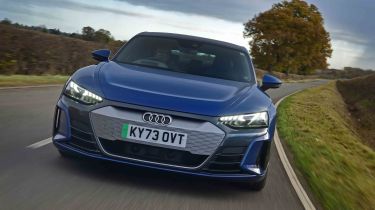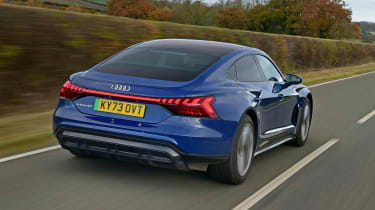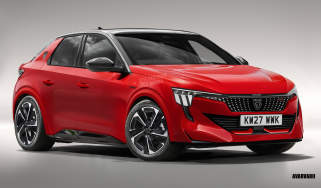Audi e-tron GT - electric motor, drive and performance
Blistering performance is guaranteed from any luxury EV, but the Audi e-tron GT is also fantastic to drive

Like most new things in the automotive world, EV tech is largely filtering down from the top. That means it’s typically the most expensive option in whichever class you’re shopping, and in the luxury saloon segment, impressive driving characteristics are a prerequisite to match – or beat – existing flagship models. The 563bhp Audi S8 saloon is a case in point, and the e-tron GT steps up to the mark with a ride and handling set-up that is truly impressive – especially when equipped with adaptive air-suspension, which can be added with the Technology Pack Pro or fitted as standard on e-tron GT Vorsprung models.
There are four selectable drive modes, with comfort best suited for UK roads. It’s soft enough to deal with rougher road surfaces while maintaining excellent body control, which means body lean in corners is almost non-existent, an area where the floaty Mercedes EQE suffers. The e-tron GT provides such a good compromise in comfort mode, that you’ll rarely even have to contemplate switching to the sportier Dynamic mode.
The latter drive mode does have some other advantages, such as shifting the torque bias towards the rear wheels, which allows for rear-wheel drive style drifts on the track if you’re so minded, while the ride and steering firm up a little. Efficiency mode has a front-wheel drive bias, with slightly slower motor responses designed to maximise range. The Individual mode allows various driving parameters to be personalised to your taste.
More reviews
Car group tests
- Audi e-tron GT vs BMW i5: executive EV powerhouses go head-to-head
- Audi e-tron GT vs Porsche Taycan 4S
In-depth reviews
Road tests
The e-tron GT is a big, heavy car at 2.3 tonnes, but positioning all the battery weight low down in the floor means it’s very well-balanced and – even without adaptive air suspension – isn’t prone to leaning over much in the bends. Like the Taycan, there’s an impressive sense of poise when cornering, although the Audi’s softer suspension settings plus its lighter steering means the Taycan feels considerably more agile.
Still, there’s a directness and precision to the e-tron GT’s steering that makes it easy to place the front end of the car through corners - a trait somewhat lacking in its BMW i5 rival. The car's weight is effectively masked by the air suspension over all but the most challenging roads, while the four-wheel steering of Vorsprung models reduces the turning circle to that of a family hatch.
Cast iron discs handle braking as standard, although more fade-resistant carbon discs are optional on all RS e-tron GT models. There’s also a regenerative braking function from the twin electric motors, which Audi calculates takes care of 30 percent of retardation in normal driving conditions. It’s useful, but the braking effect is relatively weak, and Audi hasn’t developed the system to the point where you can drive using just the accelerator pedal in stop-start traffic as you can in a Nissan Leaf.
For drivers who remain unmoved by the magic of electric propulsion, a Sound Package is available that creates digital engine noise inside the cabin and exhaust notes for the benefit of passers-by.
Engines, 0-60 acceleration and top speed
Most of the time, the twin-electric motors of the standard e-tron GT combine to put out 469bhp, with the full 523bhp potential being reserved for short 2.5-second bursts when in Dynamic drive mode and with launch control engaged. At full power, the 0-62mph time is a rapid 4.1 seconds, which is a figure you’d need the far pricier BMW i5 M60 or Mercedes EQE AMG 53 in order to beat.
Even without its ‘boost’ mode activated, the e-tron GT provides quick acceleration far exceeding a traditional petrol or diesel car, and it has no trouble getting up to motorway speeds. Our only slight complaint is a somewhat lazy accelerator response, needing a fair amount of travel before the car takes off with haste. It’s something to be aware of when merging quickly into traffic.
In the RS e-tron GT, the rear motor’s output is increased to 590bhp or 637bhp in boost mode, hence the 3.3 second 0-62mph time. On the appropriate road, the RS e-tron GT can hit 155mph flat-out, while the standard e-tron GT quattro is not far behind at 152mph.
As you’d expect from an EV, there’s no requirement for changing gear. However, unlike most EVs, the rear motor on the e-tron GT, like its Porsche Taycan sibling, has an automatically-selecting two-speed transmission with a low ratio for maximum acceleration.













